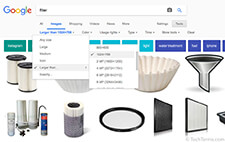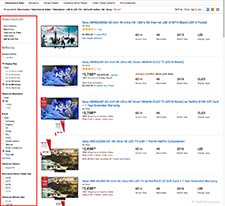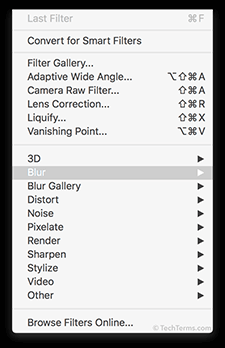Filter
In computing, the term "filter" has several different meanings. Examples include 1) search filters, 2) email filters, and 3) multimedia filters.
1. Search Filter
Many search engines allow you to filter search results. Search filtering allows you to limit the results to a reduced set that matches the filter(s) you select. For example, Google provides search filtering options in the "Tools" menu at the top of the search results page. You can filter the results to only display webpages that match your query verbatim (exactly as you typed it). You can filter image results by size, color, file type, and usage rights.
Many websites' internal search engines allow you to filter results as well. For example, e-commerce sites like Amazon and Best Buy provide filtering options when you perform a search. These options are typically found in the left sidebar of the desktop search results page. By checking different filters, you can fine-tune the results by brand, price ranges, style, rating, etc.
2. Email Filter
An email filter may refer to a spam filter or a custom filter created by a user. Spam filtering is often handled by the mail server before messages even reach a user's account. However, several mail clients allow you to create custom junk filters to further reduce the spam, or unwanted mail, that shows up in your inbox.
You can also create email filters or "rules" that automatically filter messages to specific folders within your email account. If you get a lot of messages about a particular topic, you can create a rule to automatically filter the messages to a specific folder. This can make it easier to organize your messages.
3. Multimedia Filter
A filter may also refer to a digital effect added to an image, video clip, or audio track. For example, Photoshop includes a "Filter" option in the menu bar that contains several image filters, such as blur, distort, pixelate, and sharpen. Other image filters can be used to add effects such as vibrant colors or an antique character to an image. Instagram, for instance, provides dozens of filters for modifying the appearance of photos.
Filters may also be applied to audio and video clips. For example, an audio filter can add extra reverb or chorus to a track. An autotune filter can be used to correct the pitch of a singer's voice to a specific key. Video filters can be used to add a specific visual style to a movie, such as black and white film or cinematic color tone. All multimedia filters are simply algorithms that are applied to digital media to create a desired effect.
 Test Your Knowledge
Test Your Knowledge

